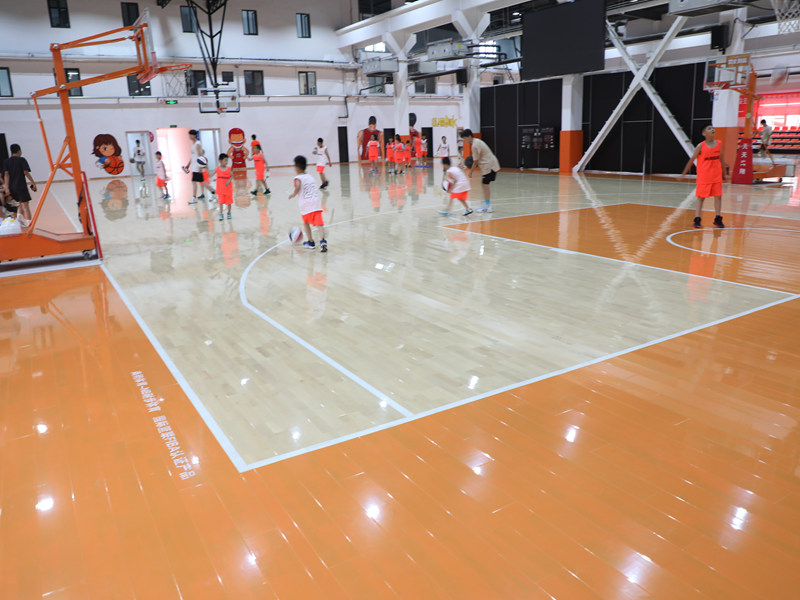
2025-07-25 17:34 Clicks:63
Here is a detailed overview of professional basketball court flooring:
Professional basketball courts are almost always made of hard maple hardwood, valued for its density, tightly grained surface, durability, and ideal ball rebound. International and league-standard tests assess the following key performance characteristics:
Shock absorption: designed to reduce athlete fatigue and joint stress.
Ball rebound: minimum bounce of 93% is required to meet performance benchmarks.
Surface friction: balanced texture is essential for player grip and safety.
Vertical deflection: controlled give (typically around 2.3 mm) to support stability without sluggishness.
Area deflection: energy dissipation across zones must fall under specified thresholds.
These align with standards such as those set by MFMA, DIN 18032‑2, EN 14904, ASTM F2772, NCAA, NBA, and FIBA regulations. Shock absorption targets at least 50%, ball rebound over 93%, and friction coefficients between 0.6 and normal thresholds.

Ensure the subfloor is dry, stable, and extremely flat. It must be properly cured and prepared to avoid future deformation or bounce problems.
Control indoor humidity (typically 35–50%) and temperature (55–75 °F). Let hardwood boards acclimate to the space for several days prior to installation to prevent warping or shrinking.
Install a resilient subfloor system including shock pads and moisture barriers over concrete to meet vertical and area deflection requirements. This ensures consistent performance and athlete safety.
Lay out hardwood planks in alignment with the rest of the court, leaving expansion gaps. Secure with appropriate fasteners following system specifications. Wood direction and spacing must be precise.
Sand the floor in progressive grit sequences until smooth. Apply sealer and finish coatings approved for sports floors. Dry and cure each coat thoroughly.
Once sealed, paint court lines and optional logos using specialized lacquer. Apply final finish coats over paint to lock in durability and visual clarity.
After surface cure, inspect for expansion consistency, bounce uniformity, friction levels, and overall quality. Facility must be climate controlled to maintain stability.
These flooring systems are engineered to meet critical athletic benchmarks:
Shock absorption: Ideal floors provide enough give to reduce injury risk and fatigue without compromising stability.
Ball rebound: Consistent bounce (93%+ for basketball) ensures predictable play.
Vertical deflection: Roughly 2.3 mm downforce supports foot control without slipperiness.
Area deflection: Ensures uniform performance across the court.
Surface traction: Friction calibrated for grip without excessive drag.
These design elements contribute to long-term safety, durability, and athlete experience.
Other materials sometimes used include:
Engineered hardwood: Combines hardwood veneer with plywood base. Offers better stability in humid or variable environments, though often limited in refinishing cycles.
Synthetic floors: Vinyl, rubber, or polyurethane surfaces provide moderate shock absorption and ease of maintenance. Popular in multi-purpose facilities but lack maple-grade bounce.
These options may meet EN or ASTM standards but typically underperform against professional maple in rebound and aesthetics.
| Aspect | Hardwood Maple Court |
|---|---|
| Material Type | Solid maple hardwood |
| Shock Absorption | Designed for ~50% or higher |
| Ball Rebound | Minimum 93% standard |
| Vertical Deflection | Approximately 2.3 mm |
| Area Deflection | Uniform energy dissipation across zones |
| Friction Coefficient | Balanced grip (around 0.6) |
| Durability | 75+ year lifespan with proper care |
| Maintenance | Daily clean, annual recoating, refinish every ~10 years |
Q: What hardwood is used for professional courts?
A: Hard maple hardwood is the universal standard due to its consistent performance in professional sport settings.
Q: Why is shock absorption important?
A: It reduces joint strain and athlete fatigue by moderating impact from jumping and running.
Q: What are acceptable bounce and friction standards?
A: Ball bounce should exceed 93%. Surface friction should support stability but allow slide without resistance.
Q: How critical is installation precision?
A: Extremely. Subfloor preparation, acclimation, layout, fastening, and finishing all affect long-term performance. Certified installers are strongly recommended.
Q: How long does a hardwood court last?
A: With proper maintenance and climate control, a maple floor can last 75 years or more with regular recoating and resurfacing.
This overview presents professional basketball court flooring in a neutral, brand-agnostic format focused on materials, standards, installation practices, and performance metrics.